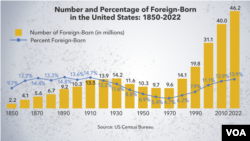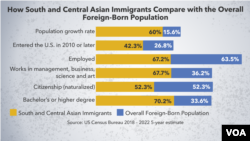How South and Central Asia’s footprint in US population is growing
The U.S. immigrant population from South and Central Asia has swelled to new heights over the past decade and continues to grow rapidly.
Between 2010 and 2022, the number of immigrants from these regions residing in the United States soared to nearly 4.6 million from 2.9 million — a jump of almost 60%, according to recently released data from the U.S. Census Bureau.
The surge dwarfs the 15.6% rise in the overall “foreign-born” population of the U.S. during the same period, the data show.
Jeanne Batalova, a demographer at the Migration Policy Institute, said the rise was “incredible.”
“We’re talking about a rate of growth of four times higher,” Batalova said in an interview with VOA.
The Census Bureau defines “foreign-born” as anyone who was not a U.S. citizen at birth, including naturalized citizens and lawful permanent residents.
The total foreign-born population of the U.S. was 46.2 million, or nearly 14% of the total population, in 2022, compared with 40 million, or almost 13% of the total population, in 2010, the Census Bureau reported April 9.

The Census Bureau data underscore just how much immigration patterns have changed in recent years. While Latin America was once the main source of migration to the U.S. and still accounts for half of the foreign-born population, more immigrants now come from Asia, Africa and other parts of the world.
Between 2010 and 2022, the foreign-born population from Latin America rose by 9%, while the flow from Asia swelled at three times that rate, with South and Central Asia accounting for the bulk of the surge.
“We are reaching out to a broader spectrum of countries than we were before,” said William Frey, a demographer at the Brookings Institution. “The old image of immigration to the U.S. as being lots of Latin Americans and Mexicans coming to the U.S. only is wrong.”
To understand immigration trends from South and Central Asia, VOA dove into the census data and spoke with demographers. Here is a look at what we found.
How many immigrants from South and Central Asia live in the U.S.?
The Census Bureau puts 10 countries in its South and Central Asia bucket: Afghanistan, Bangladesh, Bhutan, India, Iran, Kazakhstan, Nepal, Pakistan, Sri Lanka, and Uzbekistan.
The agency’s foreign-born population estimates are based in part on an annual survey known as the American Community Survey. Each estimate comes with a margin of error.
In 2022, the foreign-born population from South and Central Asia was estimated at 4,572,569, up from 3,872,963 in 2010. The margin of error was plus or minus about 55,000.
Numbering more than 2.8 million, Indians made up by far the largest foreign-born group from the region. That was up from nearly 1.8 million in 2010.
The second largest group came from Pakistan — nearly 400,000, up from nearly 300,000 12 years prior — followed by Iran with 407,000, up by more than 50,000.
But in percentage terms, several other communities from the region posted considerably larger increases.
The number of foreign-born Afghans jumped to 194,742 in 2022 from 54,458 in 2010, an increase of 257%. Batalova said much of that was due to the flood of refugees triggered by the Taliban takeover of Afghanistan.
“In terms of speed of change, [Afghanistan] outpaces all other countries in South and Central Asia,” she said.
Foreign-born Nepalese posted the second highest percentage increase, rising from 69,458 to 191,213 — a 175% jump.
There were increases of 91% and 60% respectively among immigrants from Bangladesh and Uzbekistan.

When and how did immigrants from South and Central Asia arrive in the country?
While Indians have been immigrating to the U.S. for decades, a significant proportion of immigrants from South and Central Asia are recent arrivals.
More than 42% of them entered the U.S. in 2010 or later, outpacing the nearly 27% of the total foreign-born population that settled during the same period, according to Census Bureau estimates.
Batalova noted that immigrants from South and Central Asia follow distinct paths to the United States. Indians, for instance, largely rely on student and work visas and family reunification.
Many Central Asians gain entry through the diversity visa program, with about 36% of Uzbek green card holders benefiting from the scheme. Bangladeshis, too, took advantage of the so-called “Green Card Lottery” before Bangladesh became ineligible for the program in 2012 after 50,000 Bangladeshis immigrated to the U.S. over a five-year period.
As for the recent influx of Afghan immigrants, most were admitted into the country under special immigrant visa and humanitarian parole programs following the Taliban takeover of the country.

How do educational levels and other characteristics of South and Central Asians compare with the overall foreign-born population?
Immigrants from South and Central Asia tend to have higher levels of education than the general population and are more likely to work in sought-after professional jobs.
More than 70% had a bachelor’s or higher degree, compared with nearly 34% for the overall foreign-born population, according to Census Bureau estimates for the 2018-2022 period.
Nearly 68% worked in management, business, science and the arts, compared with 36% for all immigrants.
Immigrants from India, especially, tend to enjoy high levels of education and professional jobs. Nearly 48% of Indians had graduate or professional degrees, while more than 77% worked in management, business, science, and the arts.
Where do most immigrants from South and Central Asia live?
More than half of immigrants in the United States live in just four states: California, Texas, Florida and New York.
For immigrants from South and Central Asia, however, the top four states of residence are New Jersey, California, New York and Virginia.
In New Jersey, located south of New York state, foreign-born South and Central Asians made up 3.6% of the state’s population of 9 million. In California, they account for 2.31% of the state’s population of 39 million.

How large are the diaspora communities?
The foreign-born population from South and Central Asia should not be confused with the number of U.S. residents claiming ancestry from the region.
Including second- and third-generation immigrants, the diaspora community represents a larger number.
Demographers from the Migration Policy Institute estimate that about 5.2 million people in the U.S. identify as “South Asian Indians.” About 250,000 claim Afghan ancestry.
The 2020 U.S. census found that 687,942 people identified as “Pakistani alone” or in a combination with other groups, far surpassing the estimated 400,000 foreign-born Pakistanis in the U.S.
As for the other diaspora communities from the region, “they would not be much [larger] than the total immigrant populations just because they’re more recent immigrant groups,” Batalova said.
